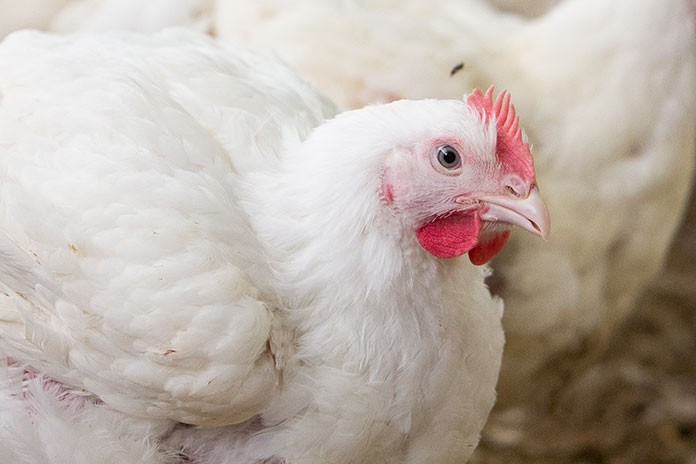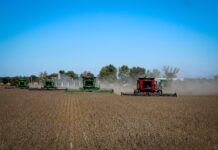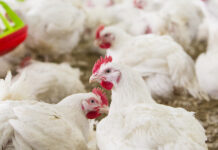
The pathogenesis leading to a form of lameness known as bacterial chondronecrosis with osteomyelitis (BCO) appears to be initiated by mechanical microfracturing of susceptible growth plates, followed by colonization of osteochondrotic clefts or voids by hematogenously distributed opportunistic bacteria.
Pathogenesis of BCO
When compared with mammalian growth plates, the avian growth plate is much thicker and the chondrocyte columns are unevenly aligned. These differences have been attributed to high longitudinal growth rates associated with very rapid growth plate turnover times in birds (estimated at 21 hours) when compared with rats (4 days) and humans (20 days). Mechanical stress chronically exerted on the growth plates creates osteochondrotic clefts or microfractures between and within the cartilage layers (e.g., physeal osteochondrosis or osteochondrosis dissecans).
Osteochondrotic clefts often transect local blood vessels, thereby causing focal ischemia and necrosis. Osteochondrosis dissecans has been observed in the leg bones and flexible thoracic vertebrae of apparently healthy broilers exhibiting no symptoms of infectious or traumatic lameness, suggesting that lameness is not necessarily caused by direct mechanical damage or osteochondrosis per se but rather by an ensuing bacterial infection.
Bacteria transmitted to chicks from breeder parents, contaminated eggshells or hatchery sources, or that enter the chick’s circulation via translocation through the integument, respiratory system or gastrointestinal tract, spread hematogenously and can reach both sides of the growth plate via numerous terminal epiphyseal and physeal vascular plexuses. These plexuses are formed when the central arteriole within a cartilage canal divides into a tuft of capillary loops that have a discontinuous or fenestrated endothelium, with openings large enough to permit cellular elements in the blood to pass into the cartilaginous matrix.
Hematogenously distributed bacteria possessing the specific ability to bind to exposed bone collagen appear in some cases to be more virulent in their capacity to trigger osteomyelitis. The translocated bacteria can form obstructive bacterial emboli in the epiphyseal and metaphyseal vascular plexuses, adhere directly to the exposed cartilage matrix, and colonize osteochondrotic clefts and zones of necrosis. Bacterial foci and sequestrae within infected bone tissue are notoriously inaccessible to antibiotics and cellular components of the immune system.
Bacterial sequestrae rapidly expand into focal zones of necrosis or large fibrinonecrotic abscesses in the metaphysis of infected bones. Terminal BCO presents as necrotic degeneration and bacterial infection primarily within the proximal ends of the femora and tibiae, as well as in the growth plates of the flexible thoracic vertebrae. The distal ends of the femora and tibiae are affected less frequently. High incidences of femoral, tibial and vertebral BCO lesions have been observed in lame broilers from commercial flocks. Multiple opportunistic organisms have been isolated from BCO lesions, including Staphylococcus aureus, Staphylococcus spp., Escherichia coli, and Enterococcus cecorum, often in mixed cultures with other bacteria including Salmonella spp.
Mechanical model for experimentally triggering BCO
The aetiology, pathogenesis, and treatment strategies for BCO have been difficult to investigate because the incidence can be low or non-existent in research flocks. Experimental models for triggering BCO are needed to confirm key triggering mechanisms and stressors, reveal innate limitations or susceptibilities, and provide a reliable test bed for evaluating practical prophylactic and therapeutic strategies. Mechanical models reliably trigger BCO without the need to purposefully inoculate the birds with known pathogens. Our assumption is that the offending pathogens routinely are present but quiescent within the bird or in the environment, waiting for an effective triggering scenario (e.g., stress, immunosuppression) and attainment of sufficient body mass to create a conducive wound site (e.g., osteochondrotic clefts, focal necrosis).
Pathogenic bacteria may be vertically transmitted from breeder hens, introduced in the hatchery, or transmitted as an aerosol or via the drinking water or feed, and then harboured subclinically at sites that have yet to be identified (e.g., intestinal, respiratory or physeal-metaphyseal microbial communities) until appropriate predisposing conditions converge. Our mechanical models were designed to create sustained footing instability and thereby persistently exert excessive mechanical stresses on susceptible leg and vertebral joints. Based on our current understanding, these amplified forces cause micro-trauma and osteochondrosis of the epiphyseal-physeal cartilage, followed by haematogenous bacterial colonization. For example, we developed portable obstacles known as “speed bumps” that consistently trigger moderate incidences of BCO in broilers.
The speed bumps are constructed in the shape of an isosceles triangular prism and are designed to be installed between feeders and waterers in litter flooring facilities, thereby forcing the birds to climb up and then down the slopes as they move back and forth to eat and drink. Speed bumps trigger 3-fold higher incidences of BCO when compared with broilers reared on litter flooring without speed bumps.
For the majority of our experiments the entire surface of the pen floor was covered with flat wire panels, thereby denying the birds access to litter and subjecting them to chronic footing instability as well as to behavioural stress. Incidences of lameness between 20% and 60% are reliably induced by this challenge, depending on the genetic susceptibility and hatchery source of the broilers being evaluated. This model consistently triggers pathognomonic BCO lesion progression, with most of the lameness developing after 5 weeks of age, as has been reported for field outbreaks of BCO. Lameness progresses very rapidly in broilers that appeared to be healthy during the preceding 24 to 48 h.
Broilers tend to exhibit relatively mild BCO lesion when they are euthanized at the earliest onset of clinical symptoms (hesitancy to stand, eagerness to sit, slight wing-tip dipping), whereas birds permitted to live until they become fully immobilized (unable to eat or drink) exhibit much more severe lesions. It also is apparent from necropsying survivors of a wire flooring experiment that severe lesions may occasionally be present in very large, apparently robust individuals that exhibit no signs of lameness or leg weakness. We speculate that broilers may purposefully avoid exhibiting overt symptoms of lameness in order to avoid being victimized by the predatory behaviour of their flock mates. Indeed, gait scoring does not accurately predict obvious skeletal pathologies or abnormalities detectable at post mortem examination.
The pathogenesis of BCO cannot be instantaneous and therefore apparently healthy broilers often possess sub-clinical lesions primarily consisting of the earliest macroscopic BCO lesion pathology. Sub-clinical lesions are equally likely to develop in males and females, in left and right legs, and the status of the proximal femur does not determine the status of the ipsilateral or contralateral proximal tibia and vice versa. These observations are consistent with the interpretation that sub-clinical mechanical damage to one or more proximal leg bones needs not trigger overt lameness until the damaged area becomes infected. The resulting bacterial proliferation, immunological assault by responding phagocytes (macrophages and heterophils), and widespread lysis and necrosis of the metaphyseal trabecular bone and vasculature then culminate in intolerable discomfort and terminal lameness.
Efficacy of prophylactic probiotic administration
Bacterial translocation and bacteraemia are essential features of our hypothesis for the pathogenesis of BCO. Tight junctional complexes comprise a key component of the intestinal barrier by sealing the apical surfaces of adjacent epithelial cells. “Leaky” tight junctions provide paracellular portals through which pathogenic bacteria can cross the gastrointestinal epithelium and ultimately enter the systemic arterial circulation. This process of bacterial leakage across the intestinal epithelial barrier, known as bacterial translocation, can lead to the haematogenous distribution of pathogenic bacteria that infect the bone. Factors known to modulate the integrity of existing tight junctions and influence the dynamic synthesis of new tight junction proteins include physiological stress and “crosstalk” (direct cell to cell signaling) between gastrointestinal epithelial cells and commensal or pathogenic bacteria of the intestinal microbial community.
Heat stress and enhanced intestinal microbial challenges can impair the integrity of tight junctions and facilitate bacterial translocation across the epithelium of the small intestine in broilers. It also has been demonstrated that probiotics alone or in combination with prebiotics can attenuate intestinal barrier dysfunction in broilers challenged by heat stress or pathogenic bacteria.
Commensal and probiotic bacterial species that enhance intestinal barrier integrity by stimulating tight junction protein expression and the formation of occlusive tight junctional complexes also are effective in preventing bacterial translocation.
In view of concerns regarding the development of antibiotic resistance in bacteria commonly associated with osteomyelitis, probiotics potentially can provide a plausible alternative for prophylactically reducing the incidence of BCO.
Probiotics may interfere with the development of osteomyelitis by attenuating intestinal populations of pathogenic bacteria, by improving gut health and integrity to reduce bacterial leakage (translocation), or by priming the immune system to better eliminate translocated bacteria.
Probiotics are not antibiotics and are unlikely to be effective if administered therapeutically only after lameness has developed in a flock. Indeed, administering probiotics in the feed beginning at 1 day of age, but not after the onset of BCO lameness, significantly reduced the incidence of lameness attributable to BCO in five independent experiments conducted over the course of two years and using four different broiler lines.
The first four of these experiments evaluated a proprietary probiotic containing Enterococcus faecium, Bifidobacterium animalis, Pediococcus acidilactici, and Lactobacillus reuteri. The fifth experiment evaluated a proprietary single microbe probiotic containing Enterococcus faecium. Prophylactically providing these probiotics in the feed consistently reduced the incidence of BCO lameness by at least 50% and without attenuating growth performance when compared with broilers that also were reared on wire flooring but were not provided probiotics in their feed.
In subsequent studies a proprietary probiotic containing Bacillus subtilis significantly delayed the age of onset and reduced the cumulative incidence of BCO lameness in broilers reared on wire flooring, whereas experiments conducted with a different proprietary Bacillus subtilis probiotic had no significant impact on the incidence of BCO lameness. Accordingly, although the specific biological mechanism remains to be determined, these experiments provide the first evidence that some, but not all, probiotics can significantly interrupt the pathogenesis of lameness attributable to BCO. Trials conducted on accumulated litter in commercial broiler facilities also have demonstrated the practical efficacy of probiotics for reducing the incidence of BCO.
Conclusions
It is our hypothesis that susceptibility to BCO is minimized by probiotics that attenuate the translocation of pathogenic bacteria into the blood stream. Based on recent evidence that the epiphyses, physes (growth plates) and metaphyses of rapidly growing bones can harbour complex microbial communities, and that major differences exist in the microbial communities in different bones and different lesion categories (macroscopically normal versus gross BCO lesions), it is intriguing to speculate that effective probiotics may improve bone health by modulating the composition and diversity of the microbial communities within the bones.
Probiotics potentially might influence growth plate microbial communities by reducing pathogen translocation, by enhancing the immune response to translocating microbial species, or via translocation of the probiotic species to the bones followed by direct modulation of a local microbial community in situ.
Probiotics are not antibiotics and are unlikely to be effective if administered therapeutically only after lameness has developed in a flock. Indeed, administering probiotics in the feed beginning at 1 day of age, but not after the onset of BCO lameness, significantly reduced the incidence of lameness attributable to BCO in multiple independent experiments conducted over a period of several years. These experiments consistently demonstrate that some but not all commercially available probiotics can, when administered prophylactically, provide an effective alternative to antibiotics for reducing lameness attributable to BCO.
References are available on request
Presented at the Australian Poultry Science Symposium
















